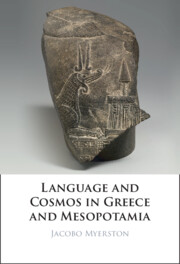
- Publisher:
- Cambridge University Press
- Online publication date:
- May 2023
- Print publication year:
- 2023
- Online ISBN:
- 9781009289962
- Subjects:
- Classical Studies, Classical Literature

Theorizing about language and its place in the world began long before Plato and Aristotle. In this book, Jacobo Myerston traces the trajectories of various proto-linguistic traditions that circulated between Greece and Mesopotamia before the institutionalization of Greek philosophy. By following the threads of transcultural conversations, the author shows the impact of Mesopotamian semantics and hermeneutics on early Greek thinkers. He reconstructs the Greek appropriation of Mesopotamian semantics while arguing that, despite geographical distance and cultural constraints, the Greeks adopted and transformed Babylonian cosmological and linguistic concepts in a process leading to new discoveries. This book covers conceptions of signification present in cuneiform word lists, esoteric syllabaries, commentaries, literary texts like Enuma elish, Gilgamesh, Hesiod's Theogony, and the Homeric Hymns as well as the philosophical commentary preserved in the Derveni papyrus.
‘I hold this book in high regard for its innovative approach. It ventures beyond the territory of Babylonian-Greek cultural exchanges to chart the journey of a singular idea across these two civilizations. This approach not only uncovers shared interests and similar ways of engaging with these interests across cultural variations but also illuminates the often-neglected field of language theory in Assyriology. This exploration is enlightening and engaging, suggesting that applying similar methodologies to other concepts and theories could reveal further commonalities between ancient cultures.’
Lucrezia Menicatti Source: Bryn Mawr Classical Review
‘This is a highly stimulating book, both in its didactic presentation of often-ignored texts relating to ancient linguistic thought, and in its innovative approach, which consists of starting from the hypothesis that these Greek and Mesopotamian texts can shed light on each other. Thus, this work enriches our understanding of ancient linguistic theories, while illustrating with remarkable clarity the circulation of these theories between Greece and the ancient Near East.’
Victor Gysembergh Source: Histoire Épistémologie Langage
 Loading metrics...
Loading metrics...
* Views captured on Cambridge Core between #date#. This data will be updated every 24 hours.
Usage data cannot currently be displayed.
This section outlines the accessibility features of this content - including support for screen readers, full keyboard navigation and high-contrast display options. This may not be relevant for you.
Accessibility compliance for the PDF of this book is currently unknown and may be updated in the future.